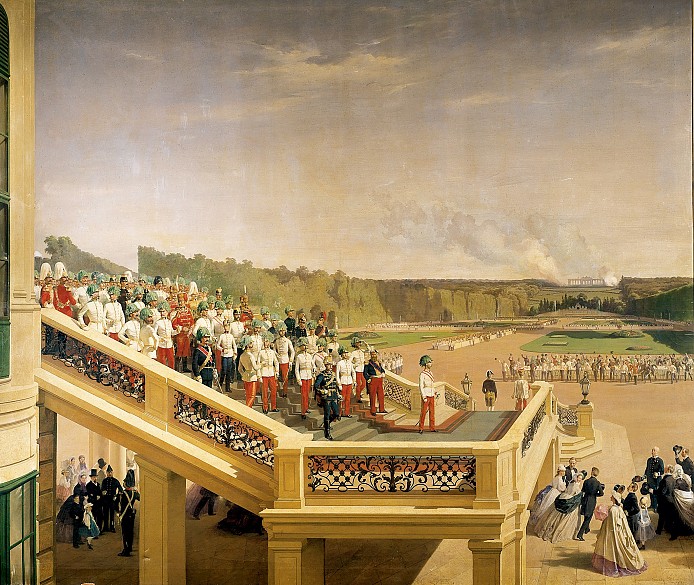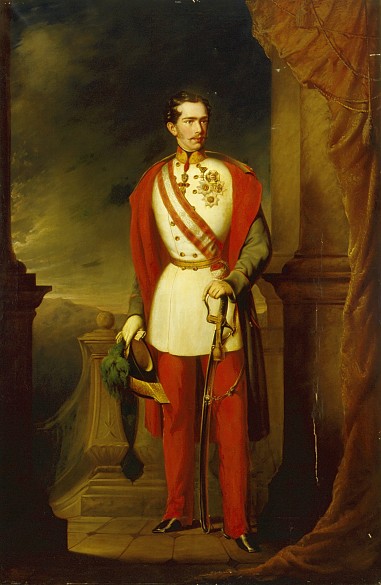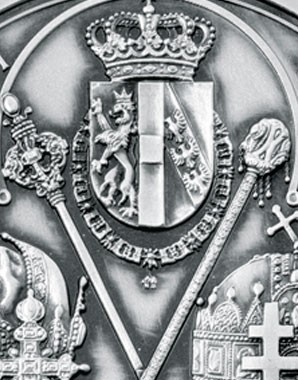Franz Joseph as ruler – Part Two: 1867–1898 – The constitutional monarch
The grave foreign-policy reverses and the self-evident failure of neo-absolutist centralism made gradual reform towards a constitutional system inevitable during the 1860s.
One of the most important results of these reforms was the Compromise with Hungary, in response to the demands of the Hungarian elite, which had taken a stance of passive resistance since the suppression of the revolution in 1848. The largest of the lands within the state system of the Monarchy, Hungary was being held down by the central authorities in Vienna, tying up huge forces that were needed elsewhere during this time of crisis. Thus a search for consensus was started which was to end in the ceremonial coronation of Franz Joseph in Budapest in 1867 and in the signing of the Compromise.
This created the Austro-Hungarian Dual Monarchy, a real union between two states that were joined only at the apex by a common head of state and a common foreign policy. The army constituted another important bond.
In all other affairs of state Hungary was granted complete autonomy. The Monarchy now had two capitals – Vienna and Budapest, which in just a few decades underwent rapid expansion to become a metropolis of European importance.
There were now two separate governments and two parliaments in parallel to one another: the Reichsrat was now convened, representing only the lands of Austria and its dependencies, known as Cisleithania for short, while the Hungarian half of the empire, known as Transleithania, had its own parliament which sat in an imposing new building on the banks of the Danube in Pest.
In many respects, developments in the Kingdom of Hungary took a very different direction to those in the Austrian half of the empire. Whereas the latter understood itself as a multi-national state, Hungary, which had an equally diverse ethnic composition, now embarked on a major policy of Magyarization. It is significant that the conglomeration of lands making up Cisleithania was officially referred to as ‘the kingdoms and lands represented in the Reichsrat’. It was not until 1917 that this group of territories was officially called ‘Austria’.
Another decisive step on the path to a constitutional monarchy was the so-called December Constitution sanctioned by Franz Joseph on 21 December 1867. The five points of the constitution established the sphere of activity of the Reichsrat, laid down fundamental civic rights, the exercise of governmental and executive power together with judicial power, and provided for the establishment of a supreme court of the empire. At the same time the February Patent of 1861 was reissued as the ‘Law on Representation of the Peoples in the Empire’. This body of laws formed the constitutional basis of the Monarchy until 1918.
A special feature of Austrian constitutionalism was the emperor’s extensive authority to exert power (monarchical constitutionalism): Franz Joseph retained the right of appointment for posts in the central bureaucracy and had the right of veto when laws were enacted.
In contrast to the British monarchy the government continued to be obliged first and foremost to the emperor rather than to Parliament. Ministers were primarily advisors to the emperor and were regarded as instruments of imperial will and not as the executive authority of the will of the people. Franz Joseph’s potential influence on government was bolstered by his right to adjourn or even dissolve the Reichsrat. In times of crisis the emperor was empowered to rule the empire without consulting the elected representatives of the people, a provision that was to severely curtail the power of the Reichsrat during the First World War.
These were the extensive rights of which Franz Joseph made repeated use and which ensured that he played a central role in political decision-making. The emperor was also the linchpin holding together the two halves of the empire, since all decisions affecting the empire as a whole, in particular in the sphere of foreign policy, were in his hands. Thanks to his passion for bureaucratic structures Franz Joseph developed an expert knowledge of administrative processes. He knew both the pitfalls and potentialities of the Imperial and Royal administrative machinery, becoming a virtuoso player on the bureaucratic keyboard.
The army represented yet another instrument of imperial power, since it was not subject to parliamentary control and obliged only to the emperor as supreme military commander, rather than to the government or the people. The Imperial and Royal Army became the symbol of the monarchy as a whole and was a central part of the identity of Franz Joseph, who saw himself as a soldier all his life. The army was organized on rigidly centralized principles and formed a bond that held the heterogeneous array of nationalities together. Any signs of federalist tendencies in the military administration were nipped in the bud by Franz Joseph.














